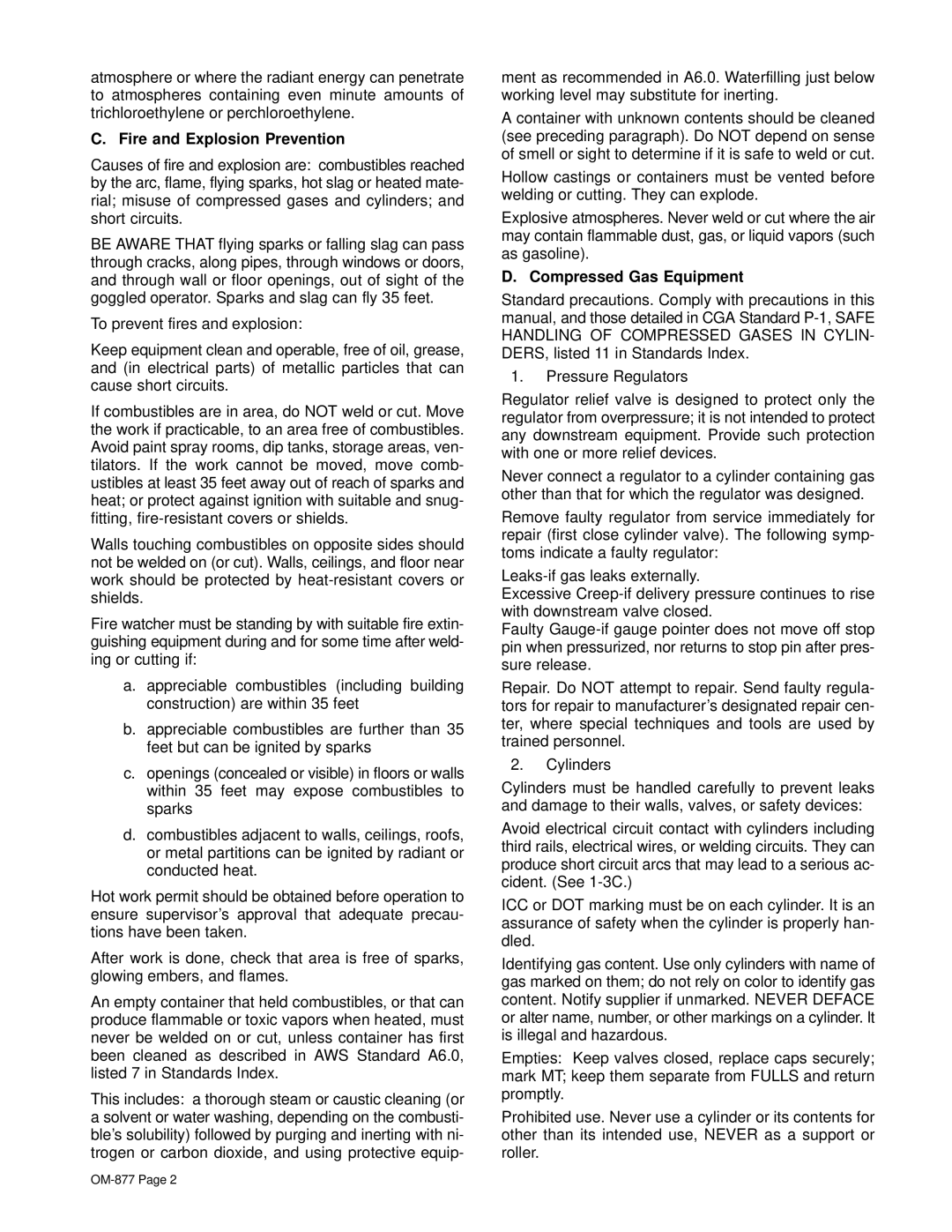atmosphere or where the radiant energy can penetrate to atmospheres containing even minute amounts of trichloroethylene or perchloroethylene.
C. Fire and Explosion Prevention
Causes of fire and explosion are: combustibles reached by the arc, flame, flying sparks, hot slag or heated mate- rial; misuse of compressed gases and cylinders; and short circuits.
BE AWARE THAT flying sparks or falling slag can pass through cracks, along pipes, through windows or doors, and through wall or floor openings, out of sight of the goggled operator. Sparks and slag can fly 35 feet.
To prevent fires and explosion:
Keep equipment clean and operable, free of oil, grease, and (in electrical parts) of metallic particles that can cause short circuits.
If combustibles are in area, do NOT weld or cut. Move the work if practicable, to an area free of combustibles. Avoid paint spray rooms, dip tanks, storage areas, ven- tilators. If the work cannot be moved, move comb- ustibles at least 35 feet away out of reach of sparks and heat; or protect against ignition with suitable and snug- fitting,
Walls touching combustibles on opposite sides should not be welded on (or cut). Walls, ceilings, and floor near work should be protected by
Fire watcher must be standing by with suitable fire extin- guishing equipment during and for some time after weld- ing or cutting if:
a. appreciable combustibles (including building construction) are within 35 feet
b.appreciable combustibles are further than 35 feet but can be ignited by sparks
c.openings (concealed or visible) in floors or walls within 35 feet may expose combustibles to sparks
d.combustibles adjacent to walls, ceilings, roofs, or metal partitions can be ignited by radiant or conducted heat.
Hot work permit should be obtained before operation to ensure supervisor’s approval that adequate precau- tions have been taken.
After work is done, check that area is free of sparks, glowing embers, and flames.
An empty container that held combustibles, or that can produce flammable or toxic vapors when heated, must never be welded on or cut, unless container has first been cleaned as described in AWS Standard A6.0, listed 7 in Standards Index.
This includes: a thorough steam or caustic cleaning (or a solvent or water washing, depending on the combusti- ble’s solubility) followed by purging and inerting with ni- trogen or carbon dioxide, and using protective equip-
ment as recommended in A6.0. Waterfilling just below working level may substitute for inerting.
A container with unknown contents should be cleaned (see preceding paragraph). Do NOT depend on sense of smell or sight to determine if it is safe to weld or cut.
Hollow castings or containers must be vented before welding or cutting. They can explode.
Explosive atmospheres. Never weld or cut where the air may contain flammable dust, gas, or liquid vapors (such as gasoline).
D. Compressed Gas Equipment
Standard precautions. Comply with precautions in this manual, and those detailed in CGA Standard
1.Pressure Regulators
Regulator relief valve is designed to protect only the regulator from overpressure; it is not intended to protect any downstream equipment. Provide such protection with one or more relief devices.
Never connect a regulator to a cylinder containing gas other than that for which the regulator was designed.
Remove faulty regulator from service immediately for repair (first close cylinder valve). The following symp- toms indicate a faulty regulator:
Excessive
Faulty
Repair. Do NOT attempt to repair. Send faulty regula- tors for repair to manufacturer’s designated repair cen- ter, where special techniques and tools are used by trained personnel.
2.Cylinders
Cylinders must be handled carefully to prevent leaks and damage to their walls, valves, or safety devices:
Avoid electrical circuit contact with cylinders including third rails, electrical wires, or welding circuits. They can produce short circuit arcs that may lead to a serious ac- cident. (See
ICC or DOT marking must be on each cylinder. It is an assurance of safety when the cylinder is properly han- dled.
Identifying gas content. Use only cylinders with name of gas marked on them; do not rely on color to identify gas content. Notify supplier if unmarked. NEVER DEFACE or alter name, number, or other markings on a cylinder. It is illegal and hazardous.
Empties: Keep valves closed, replace caps securely; mark MT; keep them separate from FULLS and return promptly.
Prohibited use. Never use a cylinder or its contents for other than its intended use, NEVER as a support or roller.
